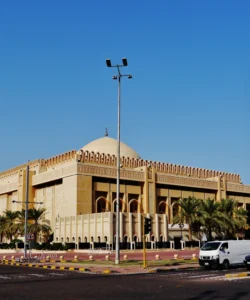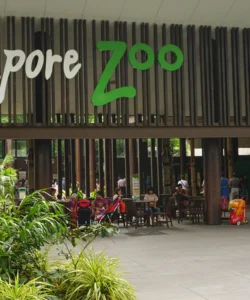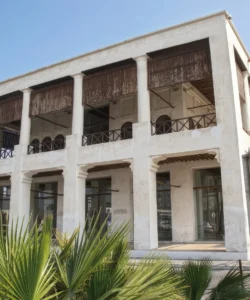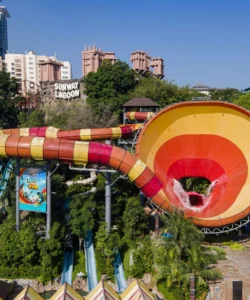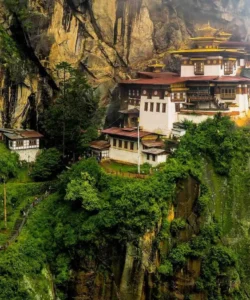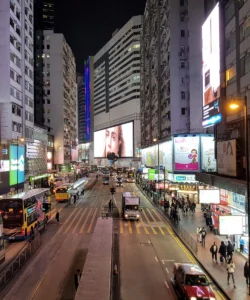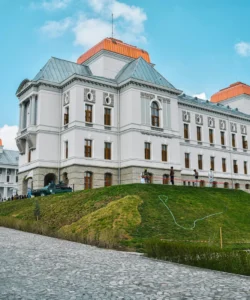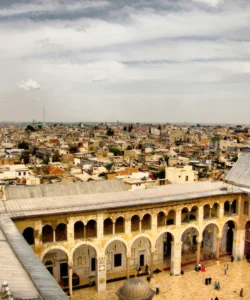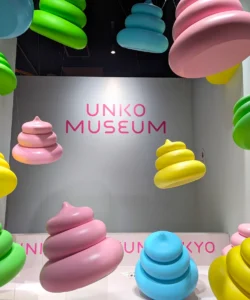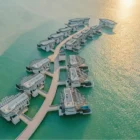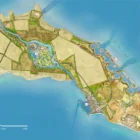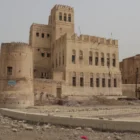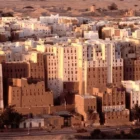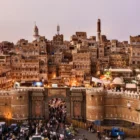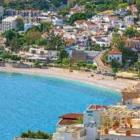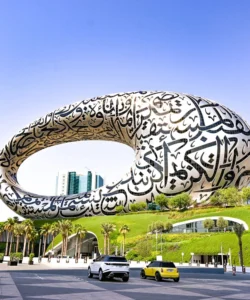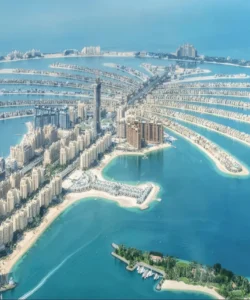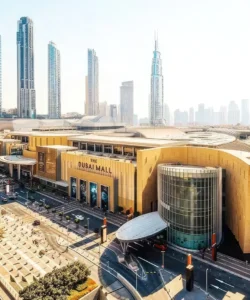Palm Jumeirah is an iconic artificial archipelago off the coast of Dubai, United Arab Emirates. Shaped like a colossal palm tree, it’s a testament to human ingenuity and a global symbol of luxury living, offering an unparalleled blend of high-end residences, world-class hotels, and diverse entertainment options.
Listen to an introduction about Palm Jumeirah
Name and Address
- Name: Palm Jumeirah (Arabic: نخلة جميرا, “Nakhlah Jumayrah”)
- Address: Jumeirah, Dubai, United Arab Emirates.
- Location: Situated off the coast of Jumeirah, Dubai, extending into the Persian Gulf. It’s easily recognizable from above due to its distinctive palm tree shape.
How to Get There
Palm Jumeirah is well-connected to mainland Dubai, offering several transportation options.
- By Car/Taxi/Rideshare: Driving onto the Palm is straightforward via the main trunk road, which connects to the mainland by bridge. Taxis, Uber, and Careem are readily available for convenient access.
- Palm Monorail: This elevated monorail system runs along the “trunk” of the Palm, connecting the Palm Gateway at the entrance to Atlantis, The Palm, at the crescent. It offers scenic views of the island and is a popular way to get around. Tickets are required (not free).
- By Metro/Tram: You can take the Dubai Metro Red Line to Dubai Internet City or Al Khail Metro Station. From there, you can connect to the Palm Jumeirah Tram, which has stops near the Palm Gateway, allowing access to the monorail.
- Water Taxis: For a unique perspective, water taxis offer a scenic way to explore the island’s architecture from the surrounding waters.
- Visitor Access: The Palm Jumeirah is open to the public. While many areas are residential or exclusive to hotel guests, visitors can access public beaches (like Palm West Beach), malls (Nakheel Mall), restaurants, and attractions like Aquaventure Waterpark.
Landscape and Architecture
Palm Jumeirah is a marvel of modern engineering and urban planning, designed to maximize waterfront properties and create a visually stunning landmark.
- Man-Made Island: Constructed using millions of tons of rock and sand dredged from the seabed, it’s recognized by Guinness World Records as the largest man-made island.
- Palm Tree Shape: The island is meticulously shaped like a date palm tree, consisting of a “trunk,” 17 “fronds,” and a surrounding “crescent” breakwater. This unique design adds significantly to Dubai’s coastline (adding 56 km).
- Zoning:
- Trunk: A mixed commercial and residential area with apartments, shops, and restaurants.
- Fronds: Primarily reserved for luxurious villas and residential homes, many with private beach access.
- Outer Crescent: Features high-end luxury resorts and hotels, such as Atlantis, The Palm, and Atlantis The Royal.
- Architectural Styles: The properties on the Palm range from classic Arabic designs to modern, high-tech alternatives, all designed with luxury and waterfront living in mind.
- Key Attractions & Features:
- Atlantis, The Palm: An iconic luxury resort featuring the Aquaventure Waterpark (one of the largest in the Middle East) and The Lost Chambers Aquarium.
- The View at The Palm: An observation deck on the 52nd floor of The Palm Tower, offering 360-degree panoramic views of the island, the Arabian Gulf, and the Dubai skyline.
- Nakheel Mall: A major shopping and dining destination located on the trunk.
- The Boardwalk: An 11-kilometer long promenade along the crescent, popular for strolls, lined with food trucks and cafes.
- Private Beaches: Many villas and hotels offer exclusive private beach access.
What Makes It Famous
Palm Jumeirah’s fame is global, stemming from its audacious scale, luxurious lifestyle, and unique design:
- World’s Largest Man-Made Island: Its sheer size and complex construction make it an unparalleled engineering feat, visible even from space.
- Symbol of Dubai’s Ambition: It embodies Dubai’s visionary approach to development and its transformation into a global tourism and luxury hub.
- Luxury Destination: Home to some of the world’s most opulent hotels, exclusive residences, and high-end dining, it’s synonymous with a lavish lifestyle.
- Iconic Shape: Its distinctive palm tree shape has made it an instantly recognizable landmark worldwide.
- Diverse Attractions: The combination of beaches, waterparks, shopping malls, and fine dining within a unique setting attracts millions of tourists annually.
Differences from Some Other Landmarks
Palm Jumeirah stands out from other landmarks in several key ways:
- Artificial Island vs. Natural or Urban Structures: Unlike natural wonders (like Wadi Bani Khalid or the Hawar Islands) or traditional urban developments (like Bab Al Bahrain or Al-Qudaibiya Palace), Palm Jumeirah is entirely man-made, a testament to modern land reclamation and engineering.
- Luxury Lifestyle Ecosystem: While other landmarks like Burj Khalifa or Bahrain World Trade Center are individual architectural icons, Palm Jumeirah is an entire, self-contained luxury ecosystem, designed for living, leisure, and tourism on a grand scale.
- Horizontal Expansion vs. Vertical Height: In contrast to the vertical ambition of skyscrapers like the Burj Khalifa or United Tower, Palm Jumeirah represents a monumental horizontal expansion of land, creating vast new waterfront areas.
- Integrated Resort Community: It functions as a sprawling, integrated resort community, offering a complete lifestyle experience with residential, hospitality, retail, and entertainment components, rather than being a single-purpose attraction.
Palm Jumeirah Photos:































